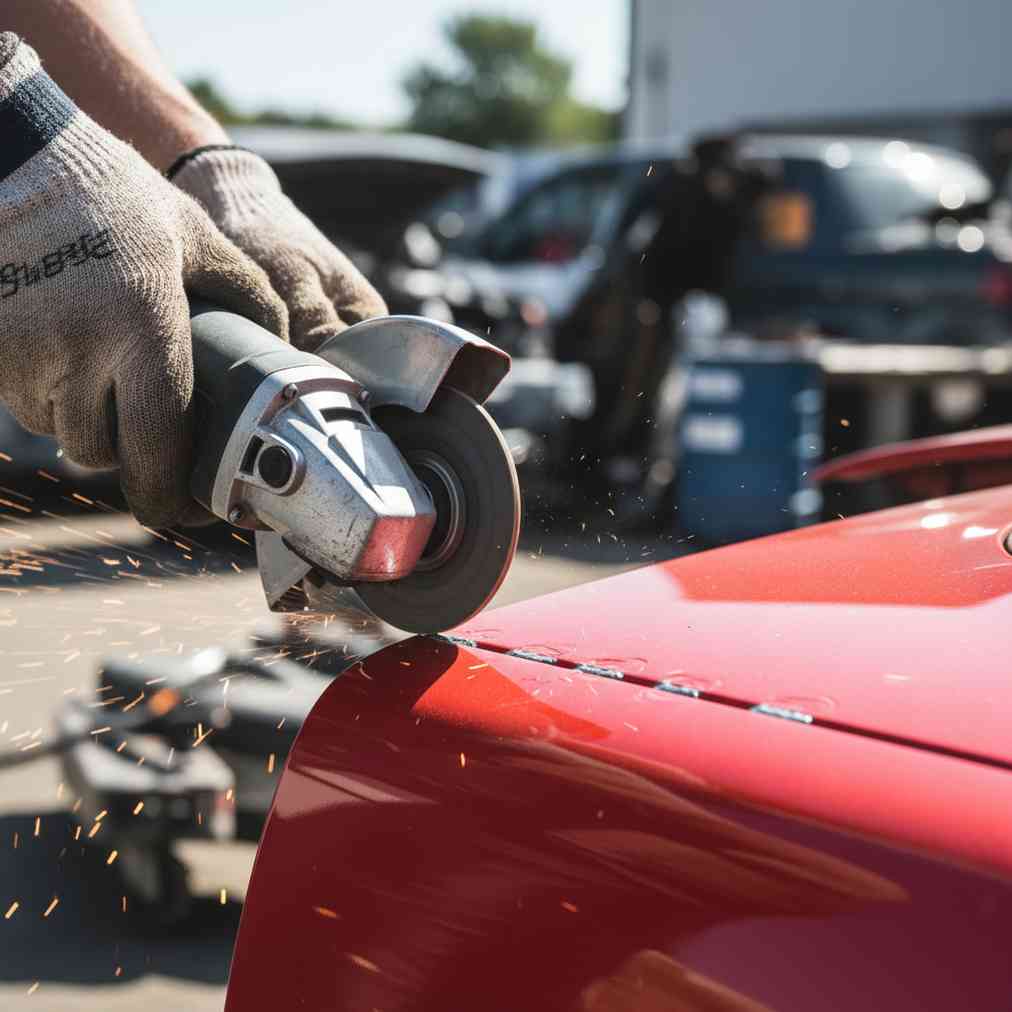Understanding the Fundamentals of Sheet Metal Cutting
Cutting automotive body panels and sheet metal from donor vehicles is a crucial skill for anyone involved in auto body restoration, repair work, or DIY car maintenance. Whether you’re harvesting parts from salvage yards near you or working on your own project vehicle, mastering proper cutting techniques ensures you preserve the integrity of valuable parts while maintaining safety standards.
The key to successful sheet metal cutting lies in understanding that precision and planning are just as important as having the right tools. Every cut you make affects both the usability of the harvested part and the structural integrity of the surrounding metal. Before making any cuts, it’s essential to identify the joining methods used by manufacturers and plan your approach accordingly.
Identifying Connection Methods: Spot Welds vs. Seam Sealer
Before you can effectively cut any body panel, you must first understand how manufacturers join metal sheets together. The two primary methods you’ll encounter are spot welds and seam sealer, each requiring different removal approaches.
Spot Welds
Spot welds are small, fused metal connections created by clamping two pieces of metal together and passing high electrical current through them. This process creates a “nugget” of fused material that holds the panels together. These welds appear as small circular indentations on the metal surface and are the primary structural connection points.
- Look for small circular marks or indentations
- Typically spaced 1-3 inches apart along seams
- May be painted over but still visible as slight depressions
- Require drilling or grinding to separate
Seam Sealer
Seam sealer is a flexible material applied over or between spot welds to prevent water and air intrusion. It’s not structural and must be removed to access the underlying spot welds. This material is often painted over and can obscure the location of actual welds.
- Appears as a raised bead along panel joints
- Flexible and can be scraped or ground away
- Often covers spot welds underneath
- Not load-bearing – purely for sealing
Essential Tools for Sheet Metal Cutting
Having the right tools makes the difference between clean, professional cuts and damaged, unusable parts. Here’s a comprehensive list of tools you’ll need for different cutting scenarios:
| Tool | Primary Use | Key Benefits |
|---|---|---|
| Spot Weld Drill Bit | Removing outer layer of spot welds | Precise, clean separation |
| Angle Grinder | Grinding down welds, rough cutting | Fast material removal |
| Pneumatic Saw | Initial rough cuts on large panels | Quick sectioning of large parts |
| Air Hammer/Chisel | Separating panels after weld removal | Controlled panel separation |
| Cutoff Wheels | Straight cuts through metal | Clean, precise cutting lines |
Safety Equipment and Precautions
Safety should always be your top priority when cutting sheet metal. High-speed cutting tools create flying debris, sparks, and sharp edges that can cause serious injuries. The data science research community has extensively studied workplace safety protocols, and similar systematic approaches apply to automotive work.
- Eye Protection: Safety goggles or face shields are mandatory
- Hand Protection: Cut-resistant gloves, though some prefer thin gloves for dexterity
- Respiratory Protection: Dust masks when grinding painted surfaces
- Hearing Protection: Ear plugs or muffs for power tools
- Work Area Safety: Keep area clear of metal shards and debris
“The metal surface will be hot and sharp immediately after cutting. Always allow cooling time and handle cut edges carefully.”
Step-by-Step Cutting Process
Successful sheet metal cutting follows a systematic approach. Just as machine learning projects require structured methodologies, cutting body panels demands careful planning and execution.
Step 1: Planning and Assessment
Before making any cuts, thoroughly assess the panel and surrounding structure. This planning phase determines the success of your entire operation.
- Identify cut lines: Mark where you’ll cut on the donor vehicle
- Plan for installation: Cut outside your intended use area when possible
- Access evaluation: Ensure you can reach all necessary spot welds
- Section large panels: Break down oversized parts into manageable pieces
Step 2: Removing Spot Welds
The goal when removing spot welds is to drill through only the outer panel layer, leaving the weld nugget intact on the inner panel. This preserves both the harvested part and the underlying structure.
- Start with a pilot hole using a 1/8″ bit to prevent wandering
- Use a spot weld cutter or specialized drill bit
- Apply firm, steady pressure
- Stop immediately when you feel resistance change
- Only drill through the first metal layer
Step 3: Alternative Cutting Methods
When spot weld drilling isn’t feasible, alternative methods can achieve similar results with proper technique.
Angle Grinder Technique: Hold the grinder nearly flat against the surface and lightly grind back and forth over spot welds until the indentation disappears. Stop before cutting into the lower panel.
Reciprocating Saw Method: Useful for rough sectioning of large panels, but requires extreme caution to avoid cutting too deep into underlying structures.
Step 4: Panel Separation
Once spot welds are weakened, carefully separate the panels using appropriate tools.
- Insert chisel between panel layers
- Work gradually along the seam
- Use leveraging motion rather than force
- Air hammers speed the process but require skill to avoid distortion
- Pliers can help twist and peel stubborn sections
Advanced Cutting Techniques
As you develop proficiency with basic cutting methods, advanced techniques can improve efficiency and part quality. These methods require additional skill but offer superior results for challenging situations.
Heat Management
Excessive heat from cutting tools can warp sheet metal, making harvested parts unusable. Proper heat management preserves part integrity:
- Take frequent breaks during extended grinding
- Watch for metal turning blue (indicates overheating)
- Use cutting fluid when possible
- Allow cooling time between cuts in the same area
Preserving Factory Flanges
Factory flanges provide crucial reference points for installation and can simplify welding processes. When cutting donor parts:
- Cut larger than your final repair area
- Preserve original flanges whenever possible
- Leave extra material for final trimming during installation
- Mark orientation before removal for easier positioning
Common Cutting Mistakes and How to Avoid Them
Learning from common mistakes can save both time and valuable parts. Here are the most frequent errors beginners make when cutting sheet metal:
| Mistake | Consequence | Prevention |
|---|---|---|
| Drilling too deep through spot welds | Damages underlying panel | Use pilot holes and feel for resistance change |
| Cutting too close to desired part | Insufficient material for installation | Always cut larger than needed |
| Ignoring heat buildup | Warped, unusable parts | Take breaks and monitor metal color |
| Improper tool selection | Rough cuts, damaged parts | Match tool to specific cutting task |
| Inadequate planning | Difficult access, poor results | Assess completely before cutting |
Specific Panel Cutting Strategies
Different types of body panels require tailored approaches for optimal results. Understanding these variations helps you choose the most effective cutting strategy for each situation.
Quarter Panels
Quarter panels are among the most challenging parts to remove due to their size and multiple attachment points. Success requires systematic sectioning:
- Make initial cuts to create manageable sections
- Work from outside edges toward center
- Preserve wheel well flanges for positioning reference
- Document piece orientation with photos before removal
Roof Skins
Roof skins present unique challenges due to their size and the need to maintain structural integrity:
- Remove interior trim for better access
- Cut along factory seams when possible
- Support large sections during removal
- Work systematically around the perimeter
Door Skins
Door skins are typically easier to remove but require attention to edge preparation:
- Remove door handles and trim first
- Cut through crimped edges carefully
- Preserve inner door frame when possible
- Clean up edges for easier installation
Quality Assessment and Part Preparation
Once you’ve successfully removed a panel, proper assessment and preparation ensure the part will serve its intended purpose. This evaluation process determines whether the harvested part meets your quality standards.
Structural Integrity Check
- Examine for cracks or stress fractures
- Check for excessive heat distortion
- Verify proper edge condition
- Assess overall flatness and shape retention
Surface Condition Evaluation
The surface condition affects both appearance and functionality of the harvested part:
- Rust assessment: Surface rust vs. structural corrosion
- Dent evaluation: Repairable vs. replacement needed
- Paint condition: Affects primer adhesion
- Contamination check: Oil, grease, or chemical residues
Storage and Transportation
Proper storage and transportation protect your investment in time and effort. Large panels are particularly susceptible to damage during handling and storage.
Storage Guidelines:
- Store panels flat when possible to prevent warping
- Use padding between stacked parts
- Protect from moisture and temperature extremes
- Label parts clearly with donor vehicle information
Transportation Tips:
- Secure parts to prevent movement during transport
- Protect edges and corners from damage
- Consider professional transport for valuable or large parts
- Document condition before and after transport
Environmental Considerations and Disposal
Responsible cutting practices include proper disposal of waste materials and environmental protection. The automotive recycling industry plays a crucial role in environmental sustainability, similar to how data science research focuses on sustainable practices.
- Metal scraps: Separate by type for recycling
- Fluids: Properly dispose of oils, coolants, and other automotive fluids
- Hazardous materials: Handle airbags, mercury switches, and other dangerous parts appropriately
- Paint waste: Contains heavy metals requiring special disposal
Building Your Skills Through Practice
Mastering sheet metal cutting requires hands-on experience and continuous learning. Start with less critical parts and gradually work up to more valuable or challenging panels.
Skill Development Progression:
- Begin with small, simple panels like trim pieces
- Practice spot weld identification and removal techniques
- Progress to larger panels as confidence builds
- Learn from mistakes and adjust techniques accordingly
- Study professional techniques through videos and training
Cost-Effective Sourcing and Planning
Smart planning can significantly reduce the cost and effort required for successful sheet metal cutting projects. If you’re working with donor vehicles that are no longer serviceable, you might consider getting cash for your junk car after harvesting needed parts.
Understanding market values and part availability helps you make informed decisions about which parts to harvest and which to source elsewhere. Sometimes it’s more economical to purchase certain parts new rather than invest time in cutting and preparation.
Future Trends in Sheet Metal Cutting
The automotive industry continues evolving with new materials and joining techniques that affect cutting strategies. Advanced high-strength steels, aluminum panels, and hybrid construction methods require adapted approaches.
Electric vehicles introduce new challenges with different panel materials and integration of electronic parts. As the industry evolves, cutting techniques must adapt to handle these emerging technologies effectively.
Professional Development and Resources
Continuous learning enhances your sheet metal cutting capabilities. Professional training programs, online tutorials, and industry publications provide valuable insights into advanced techniques and safety practices.
Many technical schools offer automotive body repair courses that include comprehensive sheet metal cutting instruction. These formal programs provide structured learning environments and access to professional-grade equipment.
Online resources, including detailed video tutorials, offer visual demonstrations of complex cutting techniques that complement written instructions.
Conclusion
Mastering the art of cutting body panels and sheet metal opens up numerous possibilities for automotive repair and restoration projects. Success depends on understanding the fundamental principles, using appropriate tools, and prioritizing safety throughout the process.
Remember that every cutting project is a learning opportunity. Start with simple parts, focus on developing proper technique, and gradually tackle more challenging panels as your skills improve. With patience, practice, and attention to detail, you’ll develop the expertise needed to harvest high-quality parts efficiently and safely.
The combination of proper planning, right tools, and systematic execution will serve you well whether you’re working on a single repair or managing multiple restoration projects. Take time to perfect your technique on less critical parts before attempting valuable or difficult-to-find panels.





Leave a Reply
You must be logged in to post a comment.